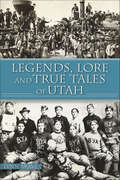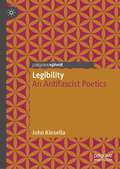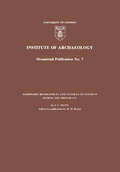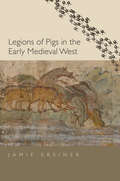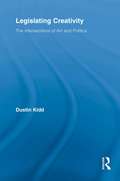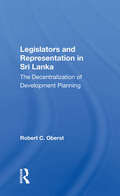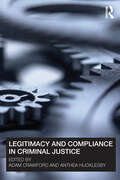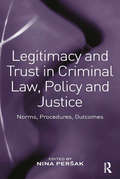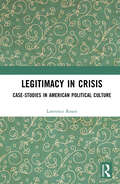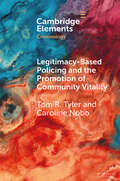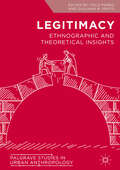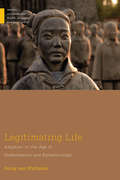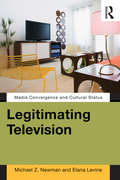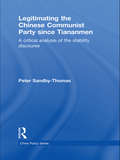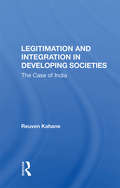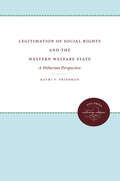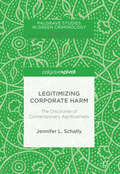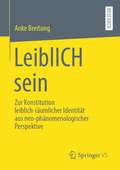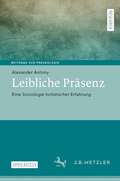- Table View
- List View
Legends, Lore and True Tales of Utah (American Legends)
by Lynn AraveLegends, Lore and True Tales of Utah explores an eclectic pastOrdinary history books often fail to address the obscure or the unexplained, leaving questions buried in annals of yesteryear. Where were Utah's mythical monsters, including Bigfoot, spotted? How did 'Schoolmarm's Bloomers' become a state symbol? What created the Lagoon Amusement Park's 'dark side'? Why did 'Frankenstein' prowl through the Cache town of Clarkston? Does Sardine Canyon hide the state's fishiest story? Exactly what was the 'Lakemobile' that rolled through the Great Salt Lake? When and why did BYU temporarily ban football? How is it that the first college basketball team to ever play in the state was all women, and they beat the men? Retired journalist Lynn Arave presents this unique collection, including over a hundred photographs, of the Beehive State's offbeat history.
Legibility: An Antifascist Poetics (Modern and Contemporary Poetry and Poetics)
by John KinsellaThis Pivot book provides a wide-ranging and diverse commentary on issues of legibility (and illegibility) around poetry, antifascist pacifist activism, environmentalism and the language of protest. A timely meditation from poet John Kinsella, the book focuses on participation in protest, demonstration and intervention on behalf of human rights activism, and writing and acting peacefully but persistently against tyranny. The book also examines how we make records and what we do with them, how we might use poetry to act or enact and/or to discuss such necessities and events. A book about community, human and animal rights and the way poetry can be used as a peaceful and decisive means of intervention in moment of public social and environmental crisis. Ultimately, it is a poetics against fascism with a focus on the well-being of the biosphere and all it contains.
Legionary Recruitment and Veteran Settlement During the Principate (UCL Institute of Archaeology Publications)
by J.C. MannThis book is a study of the settlement of legionary veterans during the principate, and discovers why legionary veterans were settled in colonies, when such settlements ceased to be made, and where the men preferred to settle when the choice was left to them.
Legions of Boom: Filipino American Mobile DJ Crews in the San Francisco Bay Area
by Oliver WangArmed with speakers, turntables, light systems, and records, Filipino American mobile DJ crews, such as Ultimate Creations, Spintronix, and Images, Inc., rocked dance floors throughout the San Francisco Bay Area from the late 1970s through the mid-1990s. In Legions of Boom noted music and pop culture writer and scholar Oliver Wang chronicles this remarkable scene that eventually became the cradle for turntablism. These crews, which were instrumental in helping to create and unify the Bay Area's Filipino American community, gave young men opportunities to assert their masculinity and gain social status. While crews regularly spun records for school dances, weddings, birthdays, or garage parties, the scene's centerpieces were showcases--or multi-crew performances--which drew crowds of hundreds, or even thousands. By the mid-1990s the scene was in decline, as single DJs became popular, recruitment to crews fell off, and aspiring scratch DJs branched off into their own scene. As the training ground for a generation of DJs, including DJ Q-Bert, Shortkut, and Mix Master Mike, the mobile scene left an indelible mark on its community that eventually grew to have a global impact.
Legions of Pigs in the Early Medieval West (Yale Agrarian Studies Series)
by Jamie KreinerAn exploration of life in the early medieval West, using pigs as a lens to investigate agriculture, ecology, economy, and philosophy In the early medieval West, from North Africa to the British Isles, pigs were a crucial part of agriculture and culture. In this fascinating book, Jamie Kreiner examines how this ubiquitous species was integrated into early medieval ecologies and transformed the way that people thought about the world around them. In this world, even the smallest things could have far†‘reaching consequences. Kreiner tracks the interlocking relationships between pigs and humans by drawing on textual and visual evidence, bioarchaeology and settlement archaeology, and mammal biology. She shows how early medieval communities bent their own lives in order to accommodate these tricky animals—and how in the process they reconfigured their agrarian regimes, their fiscal policies, and their very identities. In the end, even the pig’s own identity was transformed: at the close of the early Middle Ages, it had become a riveting metaphor for Christianity itself.
Legislating Creativity: The Intersections of Art and Politics (Routledge Advances in Sociology)
by Dustin KiddHow does political policy-making shape the creative activities of artists? Do the political interests of artists influence actual political practices in any way? Legislating Creativity examines the relationship between art and politics through an analysis of controversial art projects tied to the National Endowment for the Arts during the Culture Wars (late 1980s-1990s). Though there have always been tensions in government funding for the arts, these controversies intensified the public debates surrounding art/politics and remain as a focal point in conversations that continue today. The book focuses on three case studies: Mapplethorpe's controversial photography, an exhibit on the impact of AIDS entitled Witnesses, and the Guerrilla Girls. Dustin Kidd has provided a thoroughly enriching look at the intersections of art and politics—the ways that political practices transform creative expression and the ways that artistic drives shape political policies.
Legislators And Representation In Sri Lanka: The Decentralization Of Development Planning
by Robert C. OberstFocusing on the work of Sri Lankan legislators, this book offers a model of representation in examining parliamentary systems, especially those found in the Third World. It explores an important part of legislators' responsibilities as the country seeks to decentralize its development planning.
Legitimacy and Compliance in Criminal Justice
by Adam Crawford Anthea HucklesbyQuestions of legitimacy and issues of compliance lie at the heart of criminal justice systems and policies. Recent years have seen greater recognition and awareness of the essential role of legitimacy, trust and public confidence in underpinning the effectiveness of criminal justice practices and institutions. As such, experiences and perceptions of legitimacy have direct implications for compliance, whilst securing public compliance remains a pivotal challenge for systems of crime control. Exploring the hitherto neglected links between legitimacy and compliance raises crucial questions about the effectiveness of criminal justice and point to ways in which both elements might be enhanced. This book brings together leading international scholars to consider a number of connected themes relating to compliance, legitimacy and trust in different areas of criminal justice and social regulation. It presents an inter-disciplinary dialogue and debate that combines insights from criminology, psychology and socio-legal studies drawing together conceptual analysis with empirical research findings in relation to policing, anti-social behaviour interventions, community penalties, electronic monitoring, imprisonment and tax avoidance. In so doing, the book presents advances in theory and conceptual understandings of compliance and legitimacy within systems of crime control. The contributors highlight the importance of normative and social dimensions to compliance as well as the constructive role played by experiences of procedural fairness and legitimacy in systems of justice. This cutting-edge collection of essays will be invaluable reading for all those interested in thinking critically about the future of criminal justice policies and practices including academics, researchers and criminal justice practitioners.
Legitimacy and Trust in Criminal Law, Policy and Justice: Norms, Procedures, Outcomes
by Nina PeršakWhereas previous studies of legitimacy and trust have mostly dealt with procedural justice and the police, this book focuses on other crucial understudied aspects of legitimacy within criminal law, policy and criminal justice. The chapters expand and develop current criminological, legal and socio-legal research by addressing conceptions of legitimacy linked to criminal law norms, criminalisation and sanctioning; by examining EU legal and policy aspects of the phenomenon; and by exploring some specific court-related issues of legitimacy and trust, hitherto neglected. With contributions from across the EU, this interdisciplinary collection presents a valuable discussion on the importance of trust in legal institutions of modern democracies and suggests ideas for future research in this area to challenge ways of thinking about legitimacy.
Legitimacy in Crisis: Case-Studies in American Political Culture
by Lawrence RosenThis book takes a case study approach to explore the crisis of legitimacy in American political culture. The question of legitimacy resides at the heart of any political system. However, understanding why an individual should recognize another’s power over them is not solely limited to the analytically political but is deeply embedded in the larger cultural context of any society. Through a series of ethnographic case studies focused on the United States – from those involving the rhetoric of presidential prophecy and abuse of power to the dispute over a local sewerage authority’s reach and a case of classroom blasphemy – the book aims to demonstrate both a ground-up approach to the problem of legitimacy and to capture some of the common cultural features that bond the examples together. The book will, therefore, be of interest to scholars of anthropology, sociology, political science, and socio-legal studies.
Legitimacy-Based Policing and the Promotion of Community Vitality (Elements in Criminology)
by Tom Tyler Caroline NoboThis Element presents the history, research, and future potential for an alternative and effective model of policing called 'legitimacy-based policing'. This model is driven by social psychology theory and informed by research findings showing that legitimacy of the police shapes public acceptance of police decisions, willingness to cooperate with the police, and citizen engagement in communities. Police legitimacy is found to be strongly tied to the level of fairness exercised by police authority, i.e. to procedural justice. Taken together these two ideas create an alternative framework for policing that relies upon the policed community's willing acceptance of and cooperation with the law. Studies show that this framework is as effective in lowering crime as the traditional carceral paradigm, an approach that relies on the threat or use of force to motivate compliance. It is also more effective in motivating willing cooperation and in encouraging people to engage in their communities in ways that promote social, economic and political development. We demonstrate that adopting this model benefits police departments and police officers as well as promoting community vitality.
Legitimacy: Ethnographic and Theoretical Insights (Palgrave Studies in Urban Anthropology #Vol. 12)
by Italo Pardo Giuliana B. PratoGlobal in scope, this original and thought-provoking collection applies new theory on legitimacy and legitimation to urban life. An informed reflection on this comparatively new topic in anthropology in relation to morality, action, law, politics and governance is both timely and innovative, especially as worldwide discontent among ordinary people grows. The ethnographically-based analyses offered here range from banking to neighbourhoods, from poverty to political action at the grassroots. They recognize the growing gap between the rulers and the ruled with particular attention to the morality of what is right as opposed to what is legal. This book is a unique contribution to social theory, fostering discussion across the many boundaries of anthropological and sociological studies.
Legitimate Kid: A Memoir
by Aida RodriguezLegitimate Kid has descriptive copy which is not yet available from the Publisher.
Legitimating Life: Adoption in the Age of Globalization and Biotechnology (Medical Anthropology)
by Sonja van WichelenThe phenomenon of transnational adoption is changing in the age of globalization and biotechnology. In Legitimating Life, Sonja van Wichelen boldly describes how contemporary justifications of cross-border adoption navigate between child welfare, humanitarianism, family making, capitalism, science, and health. Focusing on contemporary institutional practices of adoption in the United States and the Netherlands, she traces how professionals, bureaucrats, lawyers, politicians, social workers, and experts legitimate a practice that became progressively controversial. Throughout the past few decades transnational adoption transformed from a humanitarian response to a means of making family. In this new manifestation, life becomes necessarily economized. While push and pull factors, demand and supply dynamics, and competition between agencies set the stage for the globalization of adoption, international conventions, scientific knowledge, and the language of human rights universalized the phenomenon. Van Wichelen argues that such technoscientific legitimations of a globalizing practice are rearticulating colonial logics of race and civilization. Yet, she also lets us see beyond the biopolitical project and into alternative ways of making kin.
Legitimating Television: Media Convergence and Cultural Status
by Elana Levine Michael Z NewmanLegitimating Television: Media Convergence and Cultural Status explores how and why television is gaining a new level of cultural respectability in the 21st century. Once looked down upon as a "plug-in drug" offering little redeeming social or artistic value, television is now said to be in a creative renaissance, with critics hailing the rise of Quality series such as Mad Men and 30 Rock. Likewise, DVDs and DVRs, web video, HDTV, and mobile devices have shifted the longstanding conception of television as a household appliance toward a new understanding of TV as a sophisticated, high-tech gadget. Newman and Levine argue that television’s growing prestige emerges alongside the convergence of media at technological, industrial, and experiential levels. Television is permitted to rise in respectability once it is connected to more highly valued media and audiences. Legitimation works by denigrating "ordinary" television associated with the past, distancing the television of the present from the feminized and mass audiences assumed to be inherent to the "old" TV. It is no coincidence that the most validated programming and technologies of the convergence era are associated with a more privileged viewership. The legitimation of television articulates the medium with the masculine over the feminine, the elite over the mass, reinforcing cultural hierarchies that have long perpetuated inequalities of gender and class. Legitimating Television urges readers to move beyond the question of taste—whether TV is "good" or "bad"—and to focus instead on the cultural, political, and economic issues at stake in television’s transformation in the digital age.
Legitimating the Chinese Communist Party Since Tiananmen: A Critical Analysis of the Stability Discourse (China Policy Series)
by Peter Sandby-ThomasThe dominant view concerning the rule of the Chinese Communist Party (CCP) is that it is simply a matter of time before it comes to an end. This view has been dominant since the pro-democracy protests in 1989 and has only been strengthened by the increasing number of protests in recent years. However, the Chinese Communist Party has continued to remain in power throughout this period and its rule appears to be secure in the short-to medium-term. As the twentieth anniversary of the military suppression of the pro-democracy demonstrations approaches, this book explains how the Chinese Communist Party has maintained its authority since 1989. It provides a detailed analysis of the Party’s discourse emphasising stability in the post-Tiananmen period, analysing the government’s propaganda in order to show how this discourse has been used by the Party to legitimate its authority. The interdisciplinary nature of this book makes it relevant to a number of different academic disciplines including Asian studies, China studies, international relations, politics and sociology.
Legitimation And Integration In Developing Societies: The Case Of India
by Reuven KahaneThis book focuses on general theoretical considerations important for the analysis of political legitimation and integration in diverse societies. It suggests a model of society in which conflicts are accentuated for integrative purposes.
Legitimation of Social Rights and the Western Welfare State: A Weberian Perspective
by Kathi V. FriedmanThis discerning and timely study revitalizes Weber's ideas, applying them to welfare state redistributions and synthesizing them with major issues in political science, law, public administration, social welfare policy, and philosophy. Friedman depicts both the emergence of the welfare state in Britain and the United States and the special problems of legitimizing social rights raised by the need for administration of those rights.Originally published in 1991.A UNC Press Enduring Edition -- UNC Press Enduring Editions use the latest in digital technology to make available again books from our distinguished backlist that were previously out of print. These editions are published unaltered from the original, and are presented in affordable paperback formats, bringing readers both historical and cultural value.
Legitimizing Corporate Harm
by Jennifer L. SchallyThis book utilizes critical discourse analysis to illuminate the ways in which one of the largest agribusinesses in operation, Tyson Foods, disguises their actions whilst simultaneously presenting the image of a benign, good corporate citizen. Schally unveils how the discourses employed by Tyson gain legitimacy by drawing on and aligning with larger cultural discourses that are often taken for granted and not adequately scrutinised. This original research, situated at the intersection of green and cultural criminologies, contributes to these current perspectives as well as to the burgeoning social harm approach within criminology. A bold and engaging study, this book will be indispensable for students and scholars of green criminology, corporate crime, animals and society, and environmental sociology, as well as environmental and animal rights activists.
Lehramtsstudium mit Migrationshintergrund: Einflussfaktoren auf die Studienfachentscheidung und den Studienverlauf
by Șeyma GülenWeshalb gibt es so wenige Lehrkräfte mit Migrationshintergrund an Schulen in Deutschland? Dieses Buch liefert anhand der Analyse des Studienwahlverhaltens und des Studienerfolges von Lehramtsstudierenden mit und ohne Migrationshintergrund Antworten auf diese Frage. Die empirischen Befunde - basierend auf den NEPS Daten - zeigen, dass die Ursachen der Unterrepräsentanz von Lehrkräften mit Migrationshintergrund stärker auf die Studienwahl als auf den Studienerfolg zurückzuführen sind. Studienberechtigte mit Migrationshintergrund zeichnen sich in ihrer Berufswahl durch Merkmale aus, die die Wahl eines Nicht-Lehramtsstudienganges begünstigen. Dazu zählen unter anderem eine hohe Aufstiegsorientierung sowie Risikobereitschaft und ein bilingualer Habitus. In ihrem Studienerfolg unterscheiden sich Lehramtsstudierende mit und ohne Migrationshintergrund hingegen nicht wesentlich voneinander. Die Autorin Șeyma Gülen hat am Institut für Soziologie der Georg-August-Universität Göttingen im Bereich der Migrations- und Bildungsforschung promoviert. Derzeit arbeitet sie als wissenschaftliche Mitarbeiterin an der Leibniz School of Education in Hannover.
Lehren und Lernen mit und in digitalen Medien im Sport: Grundlagen, Konzepte und Praxisbeispiele zur Sportlehrerbildung (Bildung und Sport #18)
by Dan MausolfDer Band beschäftigt sich mit zwei zentralen Themen, die sowohl pädagogisch, als auch gesellschaftlich und bildungspolitisch interessieren: Digitale Medien und Lehrerbildung. Beide Bereiche lassen eine medienbasierte Veränderung des universitären Lehrens und Lernens erkennen. Es werden hierzu relevante Grundlagen, Konzepte und Praxisbeispiele, speziell in der Sportlehrerbildung, vorgestellt. Sie bieten Lehrenden an der Hochschule Anregungen zur Implementierung digitaler Lehr-/Lernangebote in der eigenen Lehre, sowie einen Ausgangspunkt für eine didaktisch reflektierte Diskussion digitaler Medien in der Sportlehrerbildung.
LeiblICH sein: Zur Konstitution leiblich-räumlicher Identität aus neo-phänomenologischer Perspektive
by Anke BreitungKonstruktivistische Raumvorstellungen prägen in vielen Disziplinen die Beschäftigung mit räumlichen Dimensionen von Identitäten. Auch in der raumbezogenen Identitätsforschung dominiert eine dualistische Sichtweise, die den Körper vom Geist und den Menschen von seiner Umwelt trennt. Ortsbezogene, lokale und auch materielle Kontexte sowie die leiblichen, affektiven oder irrationalen Dimensionen unserer Erfahrungen werden außer Acht gelassen, die für Menschen zentral im Rahmen ihrer Identitätsarbeit sind. Aus diesem Grund plädiert Anke Breitung für einen holistischen Ansatz und macht dazu eine neo-phänomenologische Perspektive für die Identitätsforschung fruchtbar. Dabei werden die räumlichen Bezüge menschlicher Identitätsarbeit vom leiblichen Dasein des Menschen aus entworfen. So gelingt es ein radikal neues leiblich-räumlich-zentriertes Identitätsmodell zu entwerfen. Damit leistet die Autorin einen wichtigen Beitrag, um zu verstehen, wie die Ganzheit der sich durch uns aufspannenden Umwelt in komplexer und dynamischer Art und Weise auf die Konstruktion unseres Selbst reflexiv Einfluss nimmt.Die Autorin:Anke Breitung war als wissenschaftliche Mitarbeiterin in der Arbeitsgruppe Humangeographie der Katholischen Universität Eichstätt-Ingolstadt tätig. Ihre Schwerpunkte liegen in den Bereichen (Neo-)Phänomenologie bzw. Raumphänomenologie, Medizinische Geographie, Raumbezogene Identitätsforschung sowie Stadtgeographie und Geographische Handelsforschung.
Leibliche Präsenz: Eine Soziologie holistischer Erfahrung (Beiträge zur Praxeologie / Contributions to Praxeology)
by Alexander AntonyIn welcher Hinsicht können körperlich-leibliche Erfahrungen als Teil sozialer Aktivitäten verstanden werden und wie kann man sie sozialwissenschaftlich untersuchen? Unter Rückgriff auf den klassischen Pragmatismus, insbesondere John Dewey, und soziologische Praxistheorien leistet Alexander Antony einen Beitrag zur Beantwortung dieser Fragen. Er entwickelt eine Soziologie leiblicher Praxis, welche Sozialtheorie, methodologische Reflexion und die Erforschung der Produktion ge- und erlebter Körperlichkeit miteinander verschränkt. Empirisch widmet sich das Buch aus einer diskursanalytischen und ethnographischen Perspektive der Praktik der Atemarbeit, einem „ganzheitlichen“ Therapie- und Selbsterfahrungsangebot. Die Atemarbeit zielt darauf, eine bewusst erlebte leibliche Selbstbezüglichkeit zu etablieren, um derart körperliches, psychisches und seelisch-spirituelles Wohlbefinden zu befördern. Auf unterschiedlichen Analyseebenen spürt der Autor der Frage nach, wie individuelles leibliches Erleben und die diskursive und soziomaterielle Produktion von Erfahrungssituationen zusammenspielen. Die zentrale Einsicht: Sozialität geht buchstäblich unter die Haut.Dies ist ein Open-Access-Buch.
Leicestershire and Rutland Folk Tales
by Leicestershire Guild of StorytellingThese lively and entertaining folk tales from one of Britain's most ancient counties are vividly retold by Leicestershire Guild of Storytelling. Their origins lost in the oral tradition, these thirty stories from Leicestershire and Rutland reflect the wisdom (and eccentricities) of the counties and its people. Leicestershire and Rutland have a rich and diverse collection of tales, from stories of epic battles and heroic deeds to legends of mythical creatures and ghostly goings-on. These stories, illustrated with twenty-five line drawings, bring alive the landscape of the counties’ rolling hills and fertile plains. Leicestershire Guild of Storytelling is a group of professional storytellers who have been collecting and telling traditional stories for fifteen years. They regularly organise festivals and storytelling events.
Leistungsgewinn durch Unitarisierung: Entwicklungslinien des deutschen Föderalismus im Politikfeld Innere Sicherheit
by Luis IllanDas deutsche Politikfeld der Inneren Sicherheit unterliegt seit den 1990er Jahren einem erhöhten Anpassungs- und Optimierungsdruck. Bestehende Studien konstatieren dabei vor allem eine Tendenz zur Stärkung der Bundesebene sowie zur Einschränkung der Länderautonomie. Auf den ersten Blick liegt damit der Eindruck nahe, dass sich das ursprünglich länderautonom organisierte Politikfeld der Inneren Sicherheit auf einem Pfad zur Unitarisierung befindet, welcher häufig als eine dem deutschen Föderalismus inhärente Entwicklungslogik gesehen wird. Der politikwissenschaftliche Ertrag zur Thematik erweist sich bislang gleichwohl als defizitär. Um einen Beitrag zum besseren Verständnis föderaler Systeme im Allgemeinen sowie des deutschen Sicherheitsföderalismus im Speziellen zu leisten, werden anhand ausgewählter Fallbeispiele aus den Bereichen Polizei, Verfassungsschutz und Kriminalpolitik die Entwicklungslinien des deutschen Föderalismus seit den 1990er Jahren analysiert. Im Zentrum stehen dabei folgende Fragestellungen: Inwiefern lässt sich für das Politikfeld Innere Sicherheit tatsächlich von einer Tendenz zur Unitarisierung sprechen? Worin liegen die Ursachen für diese Tendenz begründet? Welche Effekte ergeben sich hieraus für die Leistungsfähigkeit des deutschen Föderalismus im Bereich der Inneren Sicherheit?
